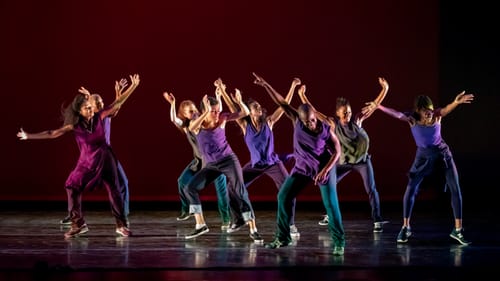Stay in the Loop
BSR publishes on a weekly schedule, with an email newsletter every Wednesday and Thursday morning. There’s no paywall, and subscribing is always free.
Still on the rise
The Kimmel Center presents Alvin Ailey American Dance Theater

Alvin Ailey American Dance Theater was back in town for the Philadelphia premiere of Rennie Harris’s Lazarus (2018), the company’s first two-act ballet. For two performances, this terrific piece shared the bill with Alvin Ailey’s seminal Revelations (1960). The program showcased the continuing relevance of Ailey’s choreography, aesthetics, and approach, connecting across the decades to Harris’s exciting new work: an homage to Ailey, an icon who developed an important, original style and helped integrate American dance.
Getting in the door
However, the evening got off to a rough start as the Academy of Music once again struggled with the process of getting ticketholders into the theater. This is a problem the Academy shares with the Merriam next door, and it’s not a new problem.
At both venues, long and slow-moving lines at Will Call block entrances from Broad Street into the vestibule and from the vestibule into the lobby, creating chaotic bottlenecks that force patrons to stand in the cold. Adding to the confusion, many patrons confuse the two venues, waiting in line for a performance that turns out to be next door. Already got your ticket? There's still a wait to get from the lobby into the theater. Ushers shouted “No late seating!” but the crowd just inside the theater doors prevented anyone from stepping inside or sitting down. The TSA routinely moves large groups of people more effectively, so surely the folks at the Kimmel Center can devise a better way to get people into its theaters.
Lazarus
Happily, I forgot the hassle as soon as Lazarus began. Its creator, a native of north Philadelphia, is best known for founding Rennie Harris Puremovement and helping to establish hip-hop concert dance. Lazarus incorporates elements of hip-hop, stepping, breakdance, and so much more. One of the best new dances I have seen in the past year, it makes thematic and stylistic connections between Harris’s work and Ailey’s. Even more impressive, Lazarus draws upon history and African American culture to craft a story of struggle, celebration, and resilience spanning from the antebellum era to the present.
Lazarus is performed to Darrin Ross’s music and sound design, which includes snippets of songs, spoken word, and other sounds. It began with the sound of human breathing, choking, and dogs barking. These sounds combined with the dancing to suggest enslavement and the Middle Passage. Harris’s choreography sharply juxtaposed movement with stillness as dancers zombie-walked and ran in slow motion. The repetition of slow-mo flight evoked the arresting silhouettes of artist Kara Walker, which explore the legacy of our country’s centuries of racist violence. Harris’s images of lynching were even more stunning. Dancers dangled their arms lifelessly, cast their heads at broken-neck angles, and gently spun their bodies as if they twisted from a tree.
The first act contained many scenes of violence, but it also celebrated the irrepressible human spirit, including a quartet of women resembling an exuberant barn dance. Gorgeous lighting by James Clotfelter highlighted tragic and joyous moments, while Mark Eric Rodriguez’s costumes enhanced connections between past and present.

The second act reprised one of my favorite earlier sequences, in which prone dancers gently moved their arms in waving patterns that first suggested seaweed and then cotton as other dancers mimed picking and filling their aprons. Next came a long, crowd-pleasing section full of the hip-hop dance for which Harris is famous. It was energetic and impressive, but not sufficiently integrated into the work as a whole. The first act’s narrative fell away, in favor of a showcase for great dancing. But Lazarus redeemed itself in the final section, which paid respect to ancestors in kinship and creativity. Ailey received special recognition, with a recording of his voice discussing the “blood memories” that inspired his work. This was a fitting conclusion to Harris’s dance, and the perfect segue into Ailey’s Revelations (1960), which closed the program.
Revelations rises again
Lazarus could not have risen without Revelations, in which Ailey distilled “blood memories” of personal and cultural heritage into powerful dances. Revelations is set to fragments of gospel, spirituals, and blues, and it was easy to see its influence on the sound design of Harris’s work. Fittingly, it also was easy to see the influence of other artists in Ailey’s choreography. For instance, the opening section’s deep pliés and sculptural moving tableaux suggested modern-dance pioneer Martha Graham.
The three parts of Revelations contained some standout sections, including Akua Noni Parker and Jamar Roberts’s duet to “Fix Me, Jesus.” Initially dancing Roberts’s shadow, Parker then performed with him a graceful series of lifts, spins, and balances that finished with her standing on his thigh. The fiery “Sinner Man” formed a dyad with “I Wanna Be Ready,” the solo performed by Jamar Roberts which preceded it. The frenetic leaping of Jeroboam Bozeman, Yannick Lebrun, and Michael Francis McBride struck a contrast with Robertson’s deliberate yet powerful movements portraying a spiritual ravishment.
Ailey’s “blood memories” endure in both Revelations and Lazarus, a new dance that both owes and pays debt to Ailey and its own blood memories. While Lazarus is a gem, it is not without flaws. But those flaws help make it real.
What, When, Where
Alvin Ailey American Dance Theater. Choreography by Rennie Harris and Alvin Ailey. March 1 and 2, 2019, at the Academy of Music, 240 S. Broad Street, Philadelphia. (215) 893-1999 or www.kimmelcenter.org.
Sign up for our newsletter
All of the week's new articles, all in one place. Sign up for the free weekly BSR newsletters, and don't miss a conversation.

 Melissa Strong
Melissa Strong